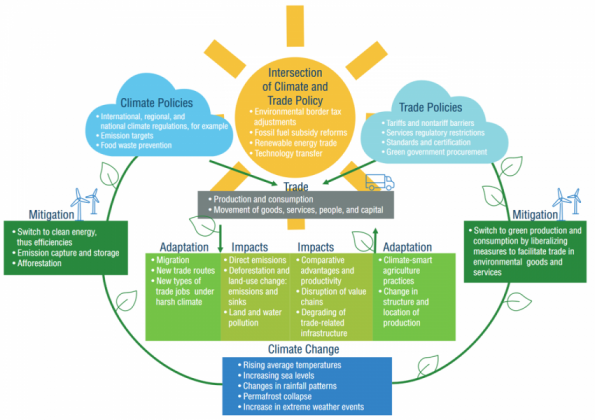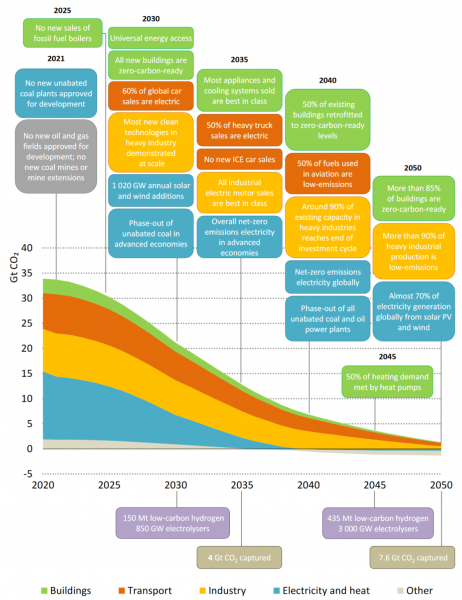

Trade and climate policies need to be checked for their impact on emissions since production should also look for the most carbon-efficient location. An ambitious climate policy, e.g., can create incentives for relocating emission-intensive products to countries without such a carbon regime.
Emerging issues in this trade and climate nexus are identifying carbon mitigation actions that increase competitiveness, stimulating and enabling the corresponding investments, and providing measures for safeguarding against adverse effects from non-cooperative actions.
The war in Ukraine will not only be a turning point for the geopolitical landscape (Heusgen 2022) but also for our understanding of the interaction of trade and climate. This nexus has suffered from disruptive changes that originated even before the outbreak of Russia’s war against Ukraine. As a result, there is currently high uncertainty about a new normal for restructuring international trade because of the war, the disruptive supply chains not only for energy, and the emerging technologies that might see hydrogen as the new internationally traded energy flow.
By elaborating on these issues, the following section provides essential evidence on the trade–climate nexus, followed by the role trade might have in reviving the failed climate policies. Finally, the geopolitics of energy and the disruption by Russia’s war are investigated, together with attempts to fix the disrupted nexus between trade and climate.
Almost one quarter of global greenhouse gas emissions result from international trade flows. Trade, in turn, is the result of decisions related to the consumption and production of goods and services regarding their amounts and locations.
Figure 1: Links between climate change and trade

Working Group III of the Intergovernmental Panel on Climate Change (IPCC) published a sobering global assessment of climate change given mitigation progress and pledges (IPCC 2022). The phase-out of fossil fuels as soon as possible is among the key messages and underpinned by the warning that global average temperatures could rise by more than 4°C by the end of the century if no action is taken. Only radical mitigation policies could prevent the world from reaching the 1.5°C temperature target of the Paris Agreement within the next two decades.
William Nordhaus (2021) diagnosed in his keynote address delivered to G-20 foreign ministers and central bank governors the failures of climate policy: a price of carbon dioxide across the world that is essentially zero; inadequate investment in low-carbon technologies; the syndrome of free-riding countries. Nordhaus concludes that even if all countries meet their Paris pledges, this will not be sufficient for meeting a two-degree climate target.
Green (2021) suggests going one step further by directly addressing economic activity issues at their source and bringing the climate agenda to international bodies such as the World Trade Organization (WTO) and the G-20. Proposed is a shift from the current multilateral process to trade, taxation, and finance issues.
A reform of WTO trade regulations could accelerate the deployment of low-carbon technologies and stimulate domestic economic activity. Domestic energy programs, e.g., that require the use of local components, currently violate WTO trade rules. Another issue is carbon border tariffs as the Carbon Border Adjustment Mechanism (CBAM) suggested by the European Commission (2021) and agreed upon by the European Council (2022). The design of this new policy instrument reflects the intention to create a level playing field in international trade. Countries with a carbon pricing mechanism like the EU Emissions Trading Scheme (EU ETS) put a levy on imports on countries without an equivalent carbon price. The design of the EU CBAM can be considered a step towards the concept of a climate club as propagated by Nordhaus. However, implementing this mechanism, which is supposed to be a central element in the EU ETS’s upcoming reform, will face significant hurdles. There are still the remaining issues of WTO compatibility, and in addition, considerable efforts will be needed to make the administrative implementation operational (Reed Smith LLP 2021).
International taxation issues are entering the discussion of a more effective climate policy. Current practices of multinational corporations to shift their tax obligations to tax heavens have massive implications on climate change. Avoiding taxes in countries where they operate provides disincentives for abating emissions. It deprives public budgets of revenues that could stimulate transformations to low-carbon structures. Cobham and Janský (2018) estimate global revenue losses of around US$500 billion annually, which is five times what developing economies were promised as financial support for their climate actions.
The Russia-Ukraine conflict has the potential of a tectonic destabilization with global dimensions. Beyond the immediate damages of the war in Ukraine that will require a recovery program in the range of one trillion US$, there will be collateral damages that are felt all over the world. The immediate reaction will be government policies that attempt to curb the inflation spikes by reducing the transition financing to low-emission structures. However, the International Energy Agency has produced several reports to discourage these counterproductive policy reactions.
Since the global financial crisis of 2007-2008, we have been witnessing the fading of hyper-globalization. Dani Rodrik (2022) provides several explanations that root in inherent contradictions: the liberal principles of the world trading system versus the interventionist policies of economies such as China; the growing inequalities in the distribution of income; the seeming inability of public policy to intervene; the geopolitical rivalry between China and the United States. Nevertheless, significant efforts are made to cope with the new challenges.
A landmark was the publication Net Zero by 2050 – by the International Energy Agency (2021). This report is a comprehensive analysis of the global energy system that considers all currently relevant targets: net-zero CO2 emissions by 2050, energy-related United Nations Sustainable Development Goals (SDGs), and limiting the global temperature rise to 1.5°C without a temperature overshoot with a 50% probability.
Some somewhat surprising conclusions concerning international trade are drawn in this IEA net-zero 2050 pathway. Large volumes of hydrogen are exported from the Middle East, Central and South America, and Australia and demanded in Asia and Europe. Beyond those already under development, no new gas fields and liquefied natural gas (LNG) liquefaction facilities are needed. Only about 35% of the current volume of natural gas will be required by 2050 and used in carbon capture utilization and storage (CCUS) facilities.
Figure 2: Key milestones in the pathway to net-zero emissions

Source: IEA (2021)
https://iea.blob.core.windows.net/assets/4719e321-6d3d-41a2-bd6b-461ad2f850a8/NetZeroby2050-ARoadmapfortheGlobalEnergySector.pdf
Russia belongs to the top three crude oil producers, Saudi Arabia and the United States, and is the world’s second-largest natural gas producer. Russia’s oil and natural gas revenues contributed 45% to the federal budget in 2021. The European Union is heavily dependent on Russian gas. In 2021 around 45% of the EU gas imports and 40% of its gas consumption originate from Russia. The International Energy Agency (IEA) (2022b) published a 10-Point Plan to Reduce the European Union’s Reliance on Russian Natural Gas. Recommended strategies include switching to other suppliers, promoting carbon-free energy sources, and accelerating efforts to provide consumers, businesses, and industry with incentives for more efficient energy use. The IEA also published a 10-Point Plan to Cut Oil Use (2022a). The recommended actions can reduce oil demand with immediate impact and can help pave the way to putting oil demand onto a more sustainable path in the longer term.
Europe faces a full-fledged energy crisis with staggering prices for electricity, gas, and oil products. Russia’s war triggers efforts for decoupling from Russian imports that were unimaginable a few months ago. Evidence is mounting that just emphasizing that clean energy resources will help lower the tensions over energy resources will not be sufficient to handle the tectonic disruptions. Ultimately, a need to deepen our understanding of energy systems arises with substantial implications for the trade and climate nexus. Two fundamental changes emerge for rethinking energy, trade, and the climate nexus.
The first step in this endeavor is opening the black box of energy systems and discovering the entire value chain that ranges from the thermal, mechanical, and specific electric energy services via application, distribution, transformation, and storage components to primary energy. Most important is discovering that the corresponding capital stock determines efficiency and amount of energy flows (Köppl and Schleicher 2018).
The second step calls for investigating and implementing targeted innovations. There are credible visions of how our building stocks can become energy self-sufficient in almost all parts of the world. We realize that mobility is a consequence of organizing living, work, and other relevant activities for our well-being. However, we still lack similar visions for hard-to-abate industries such as steel, cement, and basic chemicals. However, there are emerging concepts that these industries could become the center of a circular economy that even recycles carbon.
The third step brings to our attention the potential of new conflicts about reliability, affordability, and the security of energy supplies. Trade conflicts about hydrogen might replace the old geopolitics of oil and gas.
These steps require an even more courageous shift from the current conceptual framework shaping energy and climate policies. Nevertheless, the literature fathoms the new normal by targeted innovations and radical transformations such as Aghion, Antonin, and Bunel (2021)and Mazzucato (2021).
Aghion, Philippe, Céline Antonin, and Simon Bunel. 2021. The Power of Creative Destruction: Economic Upheaval and the Wealth of Nations. Translated by Jodie Cohen-Tanugi. Harvard University Press.
Balogh, Jeremiás Máté, and Tamás Mizik. 2021. “Trade–Climate Nexus: A Systematic Review of the Literature.” Economies 9 (3): 99. https://doi.org/10.3390/economies9030099.
Brenton, Paul, and Vicky Chemutai. 2021. The Trade and Climate Change Nexus: The Urgency and Opportunities for Developing Countries. Washington, DC: World Bank. https://doi.org/10.1596/978-1-4648-1770-1.
Cobham, Alex, and Petr Janský. 2018. “Global Distribution of Revenue Loss from Corporate Tax Avoidance: Re-Estimation and Country Results.” Journal of International Development 30 (2): 206–32. https://doi.org/10.1002/jid.3348.
European Commission. 2021. “Carbon Border Adjustment Mechanism.” European Commission – European Commission. 2021. https://ec.europa.eu/commission/presscorner/detail/en/qanda_21_3661.
European Council. 2022. “Council Agrees on the Carbon Border Adjustment Mechanism (CBAM).” 2022. https://www.consilium.europa.eu/en/press/press-releases/2022/03/15/carbon-border-adjustment-mechanism-cbam-council-agrees-its-negotiating-mandate/.
Green, Jessica F. 2021. “Follow the Money,” December 3, 2021. https://www.foreignaffairs.com/articles/world/2021-11-12/follow-money.
International Energy Agency. 2021. “Net Zero Emissions by 2050 Scenario (NZE).” IEA. 2021. https://www.iea.org/reports/world-energy-model/net-zero-emissions-by-2050-scenario-nze.
———. 2022a. “A 10-Point Plan to Cut Oil Use.” IEA. 2022. https://www.iea.org/reports/a-10-point-plan-to-cut-oil-use.
———. 2022b. “A 10-Point Plan to Reduce the European Union’s Reliance on Russian Natural Gas.” IEA. 2022. https://www.iea.org/reports/a-10-point-plan-to-reduce-the-european-unions-reliance-on-russian-natural-gas.
IPCC. 2022. “Climate Change 2022: Mitigation of Climate Change.” 2022. https://www.ipcc.ch/report/ar6/wg3/.
Köppl, Angela, and Stefan P. Schleicher. 2018. “What Will Make Energy Systems Sustainable?” Sustainability 10 (7): 2537. https://doi.org/10.3390/su10072537.
Laurens, Noémie, Clara Brandi, and Jean-Frédéric Morin. 2022. “Climate and Trade Policies: From Silos to Integration.” Climate Policy 22 (2): 248–53. https://doi.org/10.1080/14693062.2021.2009433.
Mazzucato, Mariana. 2021. Mission Economy: A Moonshot Guide to Changing Capitalism. Penguin.
Nordhaus, William. 2021. “Why Climate Policy Has Failed.” Foreign Affairs. 2021. https://www.foreignaffairs.com/articles/world/2021-10-12/why-climate-policy-has-failed.
Reed Smith LLP. 2021. “Five Key Things about the EU’s Carbon Border Adjustment Mechanism | Perspectives | Reed Smith LLP.” 2021. https://www.reedsmith.com/en/perspectives/2021/12/five-key-things-about-the-eus-carbon-border-adjustment-mechanism.
Rodrik, Dani. 2022. “A Better Globalization Might Rise from Hyper-Globalization’s Ashes | by Dani Rodrik.” Project Syndicate. 2022. https://www.project-syndicate.org/commentary/after-hyperglobalization-national-interests-open-economy-by-dani-rodrik-2022-05.
| About the author Stefan P. Schleicher is a professor at the Wegener Center for Climate and Global Change at the University of Graz. In addition, he serves as a scientific consultant at the Austrian Institute for Economic Research. He received his academic qualifications at the Institute of Technology in Graz and the University of Vienna. His academic career has taken him from the Institute for Advanced Studies in Vienna to the University of Bonn, the University of Pennsylvania, and several times to Stanford University. He has been accompanying Austrian and international energy and climate policy for years. His research focuses on sustainable economic structures, especially in energy and climate, and in the context of the unfolding disruptive developments. Current research includes the transformation of the Austrian energy system, the associated EU policies, and innovative concepts for long-term economic transitions. |